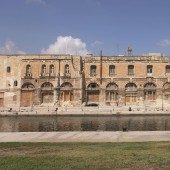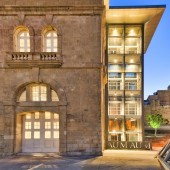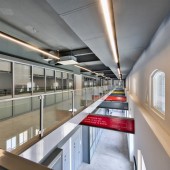AUM British Building Campus by Edwin Mintoff |
Home > Winners > #102246 |
 |
|
||||
| DESIGN DETAILS | |||||
| DESIGN NAME: AUM British Building PRIMARY FUNCTION: Campus INSPIRATION: The building's rich industrial past served as the main source of inspiration which informed the majority of design decisions taken throughout the design process. This was reflected in the intentionally exposed services of the building. The selection of raw materials and the choice to retain original structural elements, such as the voltini ceilings and the exposed riveted steel beams, emphasised this industrial feel. Another integral factor which shaped the restoration and rehabilitation of this historic building was the harnessing of sustainable initiatives in various forms. UNIQUE PROPERTIES / PROJECT DESCRIPTION: This 19th century building was severely damaged during WWII and later fell into disuse. Through EM Architects' design interventions, the building was brought back to life with a renewed purpose to serve Senglea in a new way. As well as restoring the historic fabric in a meticulous fashion, the overall building was also rehabilitated in order to usher the building into the current age whilst at the same time managing to showcase its stunning historic elements. The guiding principle behind this project remained the act of showcasing this heritage building as a protagonist of design. OPERATION / FLOW / INTERACTION: Our design incorporated the creation of 13 classrooms, 4 laboratories, 1 cafeteria, 1 library, 18 offices, 1 internal garden and 2 receptions, through minor alterations and the construction of additional floors. The cafeteria, which ensures that part of the building remains accessible to the public, also houses the restored original machinery of the building, thus incorporating these historical elements seamlessly within the new contemporary designs. PROJECT DURATION AND LOCATION: Works at Triq Dom Mintoff, Bormla, commenced in November 2016 and were completed by March 2019. |
PRODUCTION / REALIZATION TECHNOLOGY: Contemporary materials were chosen purposely so as to be visually distinguishable from the original historic fabric. This distinction is essential in order to delineate the contemporary interventions within the important timeline of this building. At its inception, this building was born out of golden Globigerina Limestone and raw steel elements, showcasing the fusion between the British Neo-Classical style and local quarried materials. SPECIFICATIONS / TECHNICAL PROPERTIES: Building is 19.6 high, 194m wide, 15.6m deep TAGS: Restoration, rehabiliation, heritage, industrial, university RESEARCH ABSTRACT: Our design began with analyzing the past history and also current situation of the area, to ensure that the restoration of such buildings would also serve to accelerate the urban regeneration of the entire area. Various historical documents, for example the text "The Malta Grand Harbour and Its Dockyard" by Bonnici and Cassar and drawings were analysed, including maps dating back to the 1840s. CHALLENGE: The main challenge of this project presented itself in the form of an existing dilapidated building, whereby its extensive character and value had been left to decay. The means by which this challenge was overcome was by successfully ushering this building into the contemporary age whilst also preserving and highlighting its original character. New volumes had to be created within and onto the existing historical fabric which was no small challenge. ADDED DATE: 2020-02-28 10:21:02 TEAM MEMBERS (3) : Edwin Mintoff, Pietro Di Raimondo and Mario Scicluna IMAGE CREDITS: Photographer: Alan Carville |
||||
| Visit the following page to learn more: https://bit.ly/2TFKbk6 | |||||
| AWARD DETAILS | |
 |
Aum British Building Campus by Edwin Mintoff is Winner in Cultural Heritage and Culture Industry Design Category, 2019 - 2020.· Read the interview with designer Edwin Mintoff for design AUM British Building here.· Press Members: Login or Register to request an exclusive interview with Edwin Mintoff. · Click here to register inorder to view the profile and other works by Edwin Mintoff. |
| SOCIAL |
| + Add to Likes / Favorites | Send to My Email | Comment | Testimonials | View Press-Release | Press Kit |
Did you like Edwin Mintoff's Cultural Heritage Design?
You will most likely enjoy other award winning cultural heritage design as well.
Click here to view more Award Winning Cultural Heritage Design.








